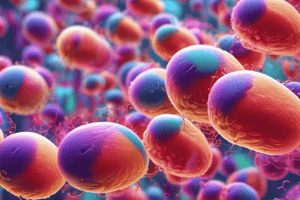Podcast
Questions and Answers
What is the primary purpose of the Epsilometer test (E test)?
What is the primary purpose of the Epsilometer test (E test)?
To provide a direct quantification of antimicrobial susceptibility of microorganisms.
How does the E-test quantify antimicrobial susceptibility?
How does the E-test quantify antimicrobial susceptibility?
By combining a disk diffusion pattern with the determination of Minimum Inhibitory Concentration (MIC).
What is meant by cultivation in the context of bacterial growth?
What is meant by cultivation in the context of bacterial growth?
To nurture and help grow bacteria.
What is the difference between aerobic and anaerobic cultures?
What is the difference between aerobic and anaerobic cultures?
What type of culture would be suitable for bacteria found on the skin surface?
What type of culture would be suitable for bacteria found on the skin surface?
What is the purpose of a culture medium in bacterial cultivation?
What is the purpose of a culture medium in bacterial cultivation?
What is the significance of Minimum Inhibitory Concentration (MIC) in antimicrobial susceptibility testing?
What is the significance of Minimum Inhibitory Concentration (MIC) in antimicrobial susceptibility testing?
How do the rectangular plastic strips used in the E-test provide a gradient of antibiotic concentration?
How do the rectangular plastic strips used in the E-test provide a gradient of antibiotic concentration?
Which type of bacteria can grow in either aerobic or anaerobic conditions, switching from aerobic respiration to fermentation or anaerobic respiration if oxygen is absent?
Which type of bacteria can grow in either aerobic or anaerobic conditions, switching from aerobic respiration to fermentation or anaerobic respiration if oxygen is absent?
What type of microorganism is typically found in the nasopharynx of healthy individuals?
What type of microorganism is typically found in the nasopharynx of healthy individuals?
Which type of bacteria requires oxygen for survival and is present in aerated moist soil containing organic carbon sources?
Which type of bacteria requires oxygen for survival and is present in aerated moist soil containing organic carbon sources?
What is the term for an organism that does not require oxygen for growth but can tolerate its presence?
What is the term for an organism that does not require oxygen for growth but can tolerate its presence?
Which type of bacteria cannot grow in the presence of oxygen?
Which type of bacteria cannot grow in the presence of oxygen?
What is the term for an organism that achieves optimal growth at low oxygen concentrations, but not in the complete absence of oxygen?
What is the term for an organism that achieves optimal growth at low oxygen concentrations, but not in the complete absence of oxygen?
Which type of bacteria is classified as an anaerobe, but can tolerate oxygen?
Which type of bacteria is classified as an anaerobe, but can tolerate oxygen?
What are the two main types of aerobic bacteria?
What are the two main types of aerobic bacteria?
What is the characteristic behavior of facultative bacteria?
What is the characteristic behavior of facultative bacteria?
What do microaerophilic bacteria require for growth?
What do microaerophilic bacteria require for growth?
What are the three main methods of cultivating anaerobic bacteria?
What are the three main methods of cultivating anaerobic bacteria?
What is the purpose of the glove-like sleeves in an anaerobic box?
What is the purpose of the glove-like sleeves in an anaerobic box?
How does an anaerobic jar create anaerobic conditions?
How does an anaerobic jar create anaerobic conditions?
What is the purpose of a candle in a candle jar?
What is the purpose of a candle in a candle jar?
Why is an anaerobic jar used to culture anaerobic bacteria?
Why is an anaerobic jar used to culture anaerobic bacteria?
How do facultative bacteria respond to changes in their environment?
How do facultative bacteria respond to changes in their environment?
What is the result of adding water to a gas generator envelope in an anaerobic jar?
What is the result of adding water to a gas generator envelope in an anaerobic jar?
Study Notes
Antimicrobial Susceptibility Testing
- Epsilometer test (E-test) is a quantitative method that provides direct quantification of antimicrobial susceptibility of microorganisms.
- It combines disk diffusion pattern with the determination of Minimum Inhibitory Concentration (MIC).
- MIC is the lowest concentration of an antimicrobial that inhibits the visible growth of a microorganism.
- E-test uses rectangular plastic strips with a predefined, continuous, and exponential gradient of antibiotic concentration.
Bacteria Culture and Cultivation
- Cultivation of bacteria is a biological activity where microorganisms multiply themselves in a predetermined culture media under laboratory conditions.
- Most bacteria can grow to some extent in the presence of oxygen, known as aerobic culture.
- Species that are naturally found in low oxygen environments, such as in deep wounds or abscesses, will typically grow best in the absence of oxygen – anaerobic culture.
- Examples of bacteria that can grow in aerobic culture include Staph. epidermidis, Staph. aureus, Streptococcus pneumoniae, Haemophilus influenza, and Moraxella catarrhalis.
Oxygen Requirements for Bacterial Growth
- Microorganisms can be found as normal flora in the nasopharynx of healthy individuals.
- Some bacteria cannot grow in the presence of oxygen at all, e.g. Fusobacterium and Bacteroides.
- Some bacteria cannot grow in the absence of oxygen, e.g. Pseudomonas and Mycobacterium tuberculosis.
- Some bacteria can grow in either aerobic or anaerobic conditions, switching from aerobic respiration to fermentation or anaerobic respiration if oxygen is absent, e.g. E. coli, Salmonella, Listeria, and Staphylococci.
Aerotolerant Organisms
- Aerotolerant organisms are those that do not require oxygen for growth but can tolerate its presence.
- An aerotolerant organism is classified as an anaerobe.
- Examples of aerotolerant organisms include Strept. pyogenes (harmful) and Lactobacillus (beneficial).
Cultivation of Aerobic and Anaerobic Bacteria
- Aerobic bacteria require oxygen for survival and are present in aerated moist soil containing organic carbon sources.
- There are two main types of aerobic bacteria: obligate aerobes and facultative and microaerophile aerobes.
- Obligate aerobes compulsorily require oxygen for energy, growth, and cellular respiration.
- Facultative bacteria can behave both aerobically and anaerobically, depending on the prevailing conditions.
- Microaerophilic bacteria require oxygen but in very low concentrations.
- Anaerobic bacteria can be cultivated using an atmosphere free of oxygen, an anaerobic indicator, and an anaerobic jar with a catalyst.
Studying That Suits You
Use AI to generate personalized quizzes and flashcards to suit your learning preferences.
Related Documents
Description
Understand the principle of Epsilometer test (E test) for antimicrobial susceptibility of microorganisms, including Minimum Inhibitory Concentration (MIC) and disk diffusion pattern. Learn about cultivation of bacteria at atmospheric conditions.




